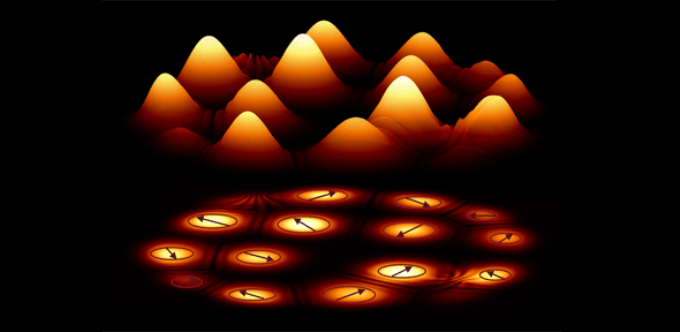Sep 27 2017
A research team from the UK and Russia have recently succeeded in demonstrating that a particular type of ‘magic dust’, which is made up of matter and light can be used for solving complicated problems and could ultimately surpass the capabilities of even the most powerful supercomputers.
 Creating polariton condensates in the vertices of an arbitrary graph and reading out the quantum phases that represent the absolute minimum of an XY Model. Credit: Kirill Kalinin
Creating polariton condensates in the vertices of an arbitrary graph and reading out the quantum phases that represent the absolute minimum of an XY Model. Credit: Kirill Kalinin
The Researchers, from Cambridge, Southampton and Cardiff Universities in the UK and the Skolkovo Institute of Science and Technology in Russia, used quantum particles called polaritons – which are half matter and half light – in order to act as a type of ‘beacon’ showing the way to the simplest solution to difficult problems.
This totally new design is capable of forming the basis of a new type of computer that has the potential to solve problems that are presently unsolvable, in varied fields such as finance, biology or space travel. The results have been reported in the journal Nature Materials.
The technological progress - from modeling protein folding and behavior of financial markets to planning new materials and transferring entirely automated missions into deep space - depends on the potential to find the optimal solution of a mathematical formulation of a problem: the absolute minimum number of steps that it takes for solving that problem.
The search for an optimal solution is similar to looking for the lowest point in a mountainous terrain with many trenches, drops and valleys. A hiker may go downhill and assume that they have reached the lowest point of the while landscape, however, there could be a deeper drop just behind the next mountain. Such a search may seem to be daunting in natural terrain, but visualize its complexity in high-dimensional space. “This is exactly the problem to tackle when the objective function to minimise represents a real-life problem with many unknowns, parameters, and constraints,” said Professor Natalia Berloff of Cambridge’s Department of Applied Mathematics and Theoretical Physics and the Skolkovo Institute of Science and Technology, and the paper’s first author.
Modern supercomputers can only deal with a tiny subset of such problems when the dimension of the function to be minimized is small or when the fundamental structure of the problem permits it to discover the optimal solution rapidly even for a function of bigger dimensionality. Even a hypothetical quantum computer, if realized, is capable of offering at best the quadratic speed-up for the “brute-force” search for the global minimum.
Berloff and her colleagues dealt with the problem from an unanticipated angle: What if instead of moving along the mountainous terrain searching for the lowest point, one fills the landscape with a magical dust that just shines at the deepest level, becoming an effortlessly detectible marker of the solution?
A few years ago our purely theoretical proposal on how to do this was rejected by three scientific journals. One referee said, ‘Who would be crazy enough to try to implement this?!’ So we had to do it ourselves, and now we’ve proved our proposal with experimental data.
Professor Natalia Berloff, Department of Applied Mathematics and Theoretical Physics, Cambridge University
Their ‘magic dust’ polaritons are developed by shining a laser at stacked layers of selected atoms such as arsenic, indium, aluminum and gallium. The electrons in these layers absorb and then emit light of a particular color. Polaritons are ten thousand times lighter than electrons and could attain sufficient densities in order to form a new state of matter called a Bose-Einstein condensate, where the quantum phases of polaritons synchronize and then produce a single macroscopic quantum object that can be detected via photoluminescence measurements.
The Researchers then had to address the question dealing with how to create a potential landscape that relates to the function to be minimized and to force polaritons to condense at its lowest point. The Researchers did this by focusing on a specific type of optimization problem, but a type that is adequately general so that any other difficult problem can be related to it, namely minimization of the XY model which is considered to be one of the most basic models of statistical mechanics.
The Authors have demonstrated that they can produce polaritons at vertices of an arbitrary graph: the quantum phases of polaritons position themselves in a configuration that corresponds to the absolute minimum of the objective function as polaritons condense.
We are just at the beginning of exploring the potential of polariton graphs for solving complex problems. We are currently scaling up our device to hundreds of nodes, while testing its fundamental computational power. The ultimate goal is a microchip quantum simulator operating at ambient conditions.
Professor Pavlos Lagoudakis, Co-Author and Head of the Hybrid Photonics Lab, the University of Southampton and the Skolkovo Institute of Science and Technology